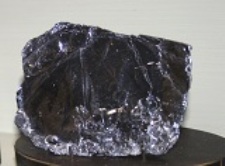Mar 2 2013
Mineral evolution is a new way to look at our planet’s history. It’s the study of the increasing diversity and characteristics of Earth’s near-surface minerals, from the dozen that arrived on interstellar dust particles when the Solar System was formed to the more than 4,700 types existing today.
 Molybdenite
Molybdenite
New research on a mineral called molybdenite by a team led by Robert Hazen at Carnegie’s Geophysical Laboratory provides important new insights about the changing chemistry of our planet as a result of geological and biological processes.
The work is published by Earth and Planetary Science Letters.
Mineral evolution is an approach to understanding Earth's changing near-surface geochemistry. All chemical elements were present from the start of our Solar System, but at first they formed comparatively few minerals—perhaps no more than 500 different species in the first billion years. As time passed on the planet, novel combinations of elements led to new minerals.
Molybdenite is the most common ore mineral of the critical metallic element molybdenum. Hazen and his team, which includes fellow Geophysical Laboratory scientists Dimitri Sverjensky and John Armstrong, analyzed 442 molybdenite samples from 135 locations and ages ranging from 2.91 billion years old to 6.3 million years old. They specifically looked for trace contamination of the element rhenium in the molybdenite, because rhenium can be used to use to gauge historical chemical reactions with oxygen from the environment.
They found that concentrations of rhenium, a trace element that is sensitive to oxidation reactions, increased significantly—by a factor of eight—over the past three billion years. The team suggests that this change reflects the increasing near-surface oxidation conditions from the Archean Eon more than 2.5 billion years ago to the Phanerozoic Eon less than 542 million years ago. This oxygen increase was a consequence of what’s called the Great Oxidation Event, when the Earth’s atmospheric oxygen levels skyrocketed as a consequence of oxygen-producing photosynthetic microbes.
In addition, they found that the distribution of molybdenite deposits through time roughly correlates with five periods of supercontinent formation, the assemblies of Kenorland, Nuna, Rodinia, Pannotia, and Pangea. This correlation supports previous findings from Hazen and his colleagues that mineral formation increases markedly during episodes of continental convergence and supercontinent assembly and that a dearth of mineral deposits form during periods of tectonic stability.
“Our work continues to demonstrate that a major driving force for mineral evolution is hydrothermal activity associated with colliding continents and the increasing oxygen content of the atmosphere caused by the rise of life on Earth,” Hazen said.
Hazen’s other co-authors were Joshua Golden, Melissa McMillan, Robert T. Downs, Grethe Hystad, and Ian Goldstein of the University of Arizona; and Holly J. Stein and Aaron Zimmerman of Colorado State University (the former also of the Geological Survey of Norway).